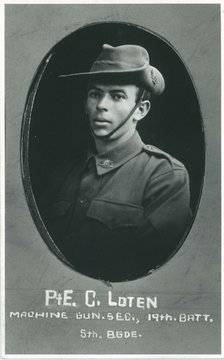LOTEN, Clarence Edgar
| Service Number: | 1461 |
|---|---|
| Enlisted: | Not yet discovered |
| Last Rank: | Private |
| Last Unit: | 19th Infantry Battalion |
| Born: | Taree, New South Wales, Australia, date not yet discovered |
| Home Town: | Stanmore, Marrickville, New South Wales |
| Schooling: | Not yet discovered |
| Occupation: | Clerk |
| Died: | 1965, cause of death not yet discovered, place of death not yet discovered, age not yet discovered |
| Cemetery: | Not yet discovered |
| Memorials: | Mitchells Island WW1 Roll of Honour, Sydney Municipal Council of Sydney Employees Honour Roll |
World War 1 Service
| 25 Jun 1915: | Involvement Private, 1461, 19th Infantry Battalion, --- :embarkation_roll: roll_number: '13' embarkation_place: Melbourne embarkation_ship: HMAT Ceramic embarkation_ship_number: A40 public_note: '' | |
|---|---|---|
| 25 Jun 1915: | Embarked Private, 1461, 19th Infantry Battalion, HMAT Ceramic, Melbourne |
Help us honour Clarence Edgar Loten's service by contributing information, stories, and images so that they can be preserved for future generations.
Add my storyBiography contributed by William Valarezo
Clarence Edgar Loten
Clarence Edgar Loten was born in 1893 in Taree NSW, Loten worked as a clerk in Stanmore NSW when he enlisted into the AIF on the 8th of March 1915 at the age of 21 years old. He was quickly placed into the original “D” company of the 19th battalion. Loten along with the 19th embarked from Sydney on the 25 of June and landed at Gallipoli on the 16th of August 1915.While at Gallipoli Loten took part in the last action of the August offensive, the attack on hill 60 which resulted in the failure to conquer the hill. Loten was sent to Hospital on the 27th of September but released just a day later. Loten was promoted to sergeant on the 15th of October. After being promoted to Sergeant, Loten would spend the rest of his time at Gallipoli in defensive trenches before evacuating from Gallipoli from the 15th-19th of December . After further training in Egypt he embarked to France and landed at Marseilles on the 7th of March 1916 and a day later transferred to the 5th Australian machine gun company, while being stationed with the 5th MGC the 5th MGC fought through the bloody battle of Fromelles which resulted in the death of over 5,500 Australian soldiers. A month later during the battle of Pozieres, on the 4/5th of August sgt Loten , while in charge of a machine gun had advanced into O.G.1 trench at Pozieres, and though encumbered with ammunition boxes succeeded in the effective capture of 6 German Prisoners. After his actions sgt Loten was promoted to Company Sergeant Major on the 2nd of September 1916 and 14 days later on the 16th of September for his actions on the 4/5th of August Loten was recommended for a DCM with this citation For conspicuous gallantry on the night of the 4th/5th August. When in command of a gun he advanced into the O.G.1 trench at Pozieres, and though encumbered with ammunition boxes, succeeded in effecting the capture of six prisoners. Just a month later after being recommended for the DCM on the 4th of October CSM Loten was commissioned in the field to 2nd Lieutenant. Later the 5th took part in the final battles of the Somme, here on the 14th of November Loten was WIA with a shrapnel wound to the head, he was evacuated to the 2nd field hospital at Rouen France. Recovering from his wound Loten was promoted to Lieutenant and on the 24th of April 1917 and rejoined his battalion. On the first day of the second battle of bullecourt Loten was WIA ( second occasion ) with a GSW to his elbow. He was evacuated to Boulogne, Belgium . Recovering from his wounds 2 months later he was given 6 months leave in England to take up duty with the Ministry of Munitions in London. He married Miss L M Loten, a London local. Loten never fully recovered from his wounds received at Bullecourt and on the 12th of March 1918 returned to Australia suffering from left arm paralysis. his appointment as an officer was terminated on the 12 of August the same year.
LT Lotens DCM was awarded to him on the 1st of January 1917.
An honourable Australian officer
Clarence edgar Loten
1893-1965
written by William Valarezo using extracts from the Australian War Memorial









